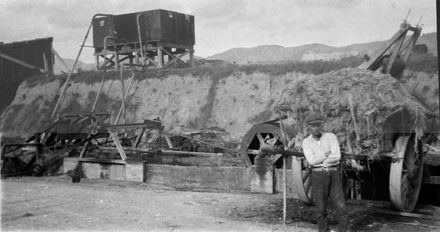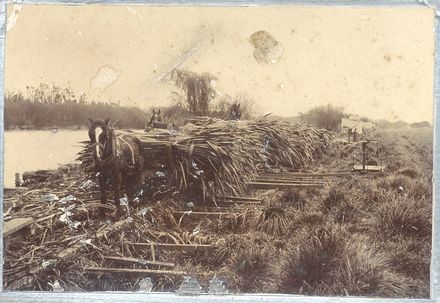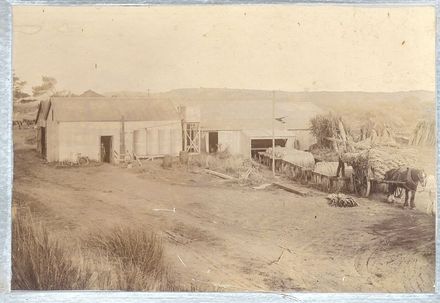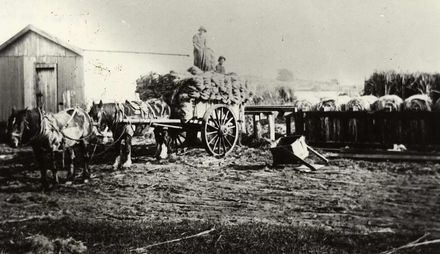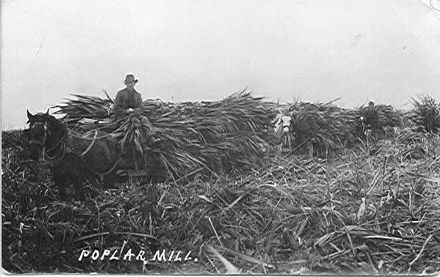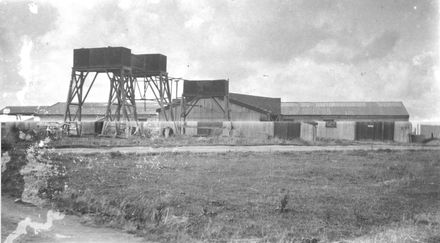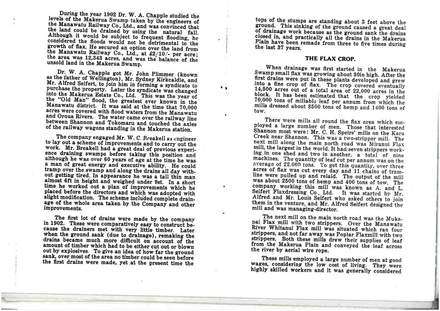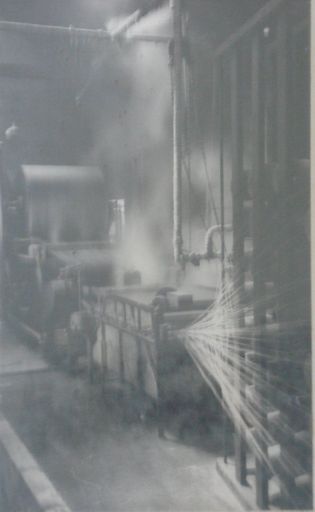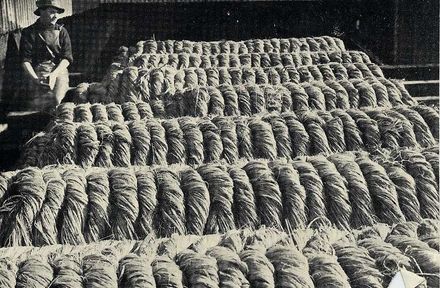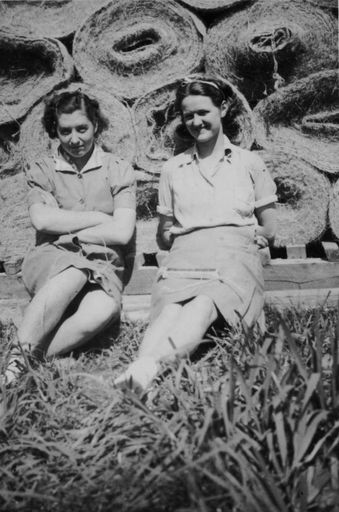THE PAIAKA MILL.
Mr Gardner's hemp mill is situated on the banks of the Manawatu River, about ten miles up above Foxton. It seems strange to believe that as far back as thirty or thirty five years ago, the very spot on which the mill now stands, was then a scene of bustling industry, and the whirr of the steam saw and flour mill sounded strange in the ears of the Native customers.
At that period Mr Thomas Kebbel did a large business with the Maories at this spot, as well as did Mr Cook, on the bank of the river just opposite. The Natives, we are told, were exceedingly industrious and grew great quantities of wheat and potatoes, which they brought from the further side of the Manawatu Gorge to this market.
The old mill buildings still stand, apparently as strong and sound as the day they were erected, ss does the old wharf, though it has suffered more from the effects of time. Close to the old mill buildings still stands the old retail shop, which could reveal some strange deaIs if it could only speak The old dwelling house is also standing.
When the native trade fell off, Mr Kebbell moved the flour mill to Te Aro at Wellington, and Mr Cook removed his store to Foxton. Thus for a time this busy spot became deserted, and excepting the use of the land for grazing, the scene lapsed into its native solitude.
This was broken into again about seven years ago, when the demand for timber arose, and again on the opposite side of the river the steam engine was requisitioned for turning the treesinto suitable building timber. On this trade becoming slack the plant was used for flax dressing, but after passing through two or three different hands, the most saleable portions were taken away, and peace and quietness allowed to reign.
Once again, owing to the push and enterprise of Mr Robert Gardner, the air resounds with the roll of the flax stripper and the thud of the scutcher, and the PAIAKA HEMP MILL stands firmly placed on the bank of river.
The design of the mill is very compact, and covers a space of 35 feet square, which is all roofed over with galvanised iron. In this, the main building, stands a new portable 12 horsepower engine, made by Marshall & Son, three of Cable's strippers, and the washing trough, also a blacksmith's shop. The strippers are raised some seven feet high and are placed adjacent to a large opening, through which the green flax, after being weighed, is placed into shoots at the right hand of the feeders. The engine is to the right of the strippers. To the left of the strippers is a long washing trough, which is placed off the ground at such a height that the men washing can conveniently reach it, and at such a slant as secure a regular rush of water. The washing trough has pins across it at regular distances, on which the hanks, being washed, are caught.
The water is obtained direct from the river by a californian pump, which is accommodated to the tide by a floating platform. The length of the pump is 28 feet. The water trough extends from the river to the strippers, and at this point a very steep fall is given to the box, and the water is thrown into a drain below the strippers, catching the most of the green bark of the leaf of the flax, which is thus carried off by a drain to the river. This saves a large amount of labor.
After washing, which is effected by a quick flow of water, and by being scraped down whilst the water is running over the fibre, with a wooden plane, the fibre is placed outside the building ready for the carts to carry to the bleaching grounds.
Across this road is the scutching and baling shed, a large wooden building 35 x 16 feet. The bales after being made up are carted to the old milk shed, and thence sent to the Kereru station on the Manawatu Railway Company's line. To save handling, Mr Gardner has erected a private ferry over the river, and the punt is large enough take dray and three horses. Mr Thompson, who has had to do with hemp for many years on the Nelson side, is the manager, and to whom Mr Gardner has submitted full control, and has expressed himself very well satisfied at having done so.
The buildings were erected by Messrs Bacon and Speirs, who have now started business in Foxton. Mr Kemp is the engineer. The mill bears the appearance of having been designed and erected by men who thoroughly understood their business.
On the road to Kereru station Mr Gardner has a large quantity of bush, and his drays load back with firewood. The distance of the back loading is not more than a mile and a half, so that the cost of the wood at the mill can easily be estimated.
Mr Kemp informed us that at the start they burnt coal and wood mixed, but he purposed only using wood, which, as coals cost landed at the mill thirty five shillings a ton, and he reckoned that from two cords to two cords and a half, would equal a ton of coal, a good saving would be effected.
Until the past week, only two strippers had been at work, and they had turned out ten tons of dressed fibre a week, but with the three strippers they expected to put out fifteen tons a week. Last Saturday morning the three strippers ran through 5½ tons of green flax in four hours. The whole of the stripping scutching, baling, and fielding is let by contract, as is also the cutting of the green flax.
At a short distance from the mill is the sleeping house, 32 x 23 feet, in which are fitted a row of bunks built up from the floor away from the walls, containing in one row, three tiers higb, twenty four bunks. There are a few small ones in one end of the room, and another tier of twenty four are to be built running parallel with the first lot. Down the centre will be a passage way over eight feet wide, and there is a four feet space between the bunks and the walls. There will be an American stove placed in this building for the winter. A few feet away is the dining room, which is 46 x 12 feet, to which is attached the kitchen and store room. The catering used to be let by contract, but as it has not proved satisfactory, Mr Gardner intends to find the food and cook.
There are five two horse teams now working at the mill, and two more were expected this week. The old dwellng is set apart for the use of Mr Gardner when he runs up, which he generally does once a week, and for the residence of his two sons, who are employed at the mill, and for Mr Beauchamp, the manager of the farm, and Mr Thompsom, the mill manager.
Here is kept ihe piano, which was sent up for the benefit ot tbe employees, and here also is kept the library, so that the interests of those employed by Mr Gardner are cared for. Mr Gardner has further expressed his desire to foster the amusements of his hands in every reasonable way, and a football club is now bang formed On Sunday evening service is held in the sitting room of the house, to which all axe invited, but none are forced to attend, and it is pleasing to learn that the room is generally filled.
There are between 35 and 40 hands employed at present, though the extra stripper will probably cause the number to be increased. Some of the married men are supplied with cottages that lie on Mr Gardner's property on the opposite side of the river, they having been erected during the time the sawmill was at work.
Mr Gardner's aim is to make his mill the most comfortable one in the district, believing by so doing, not only will he secure the best and steadiest hands, but that he will also succeed in identifying the interest of the employees with his, thus securing better work, and more light-heartedly done. We wish him every success.
From: Papers Past - use this link to see the complete article:
http://paperspast.natlib.govt.nz/cgi-bin/paperspast?a=d&cl=search&d=MH18890418.2.10&srpos=16&e=-------10--11--on--2the+paiaka+mill--


